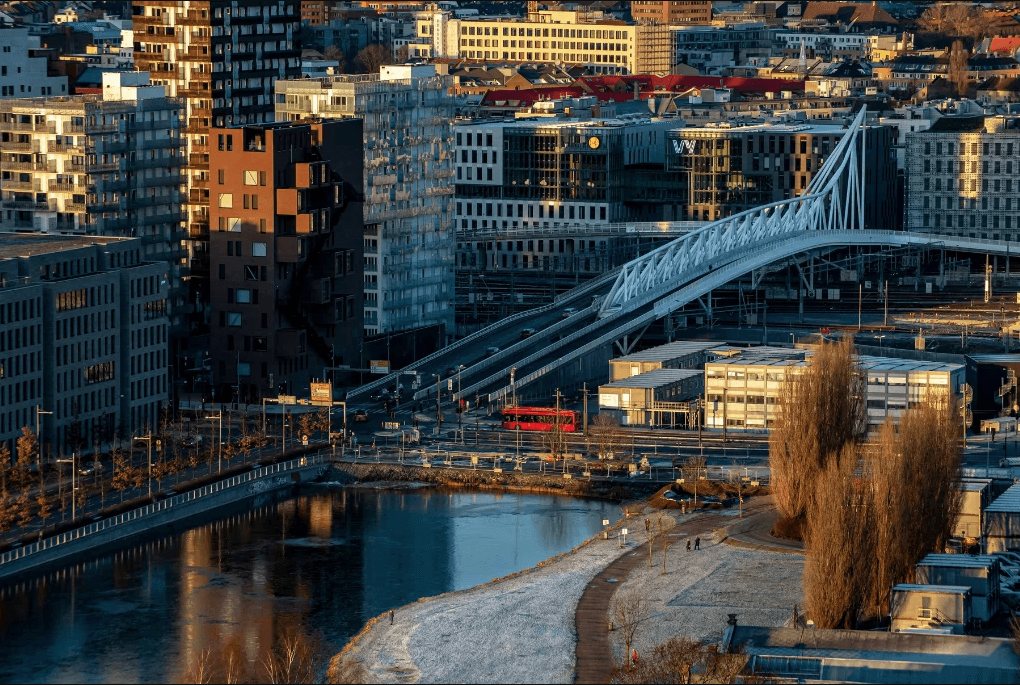Cars and vehicles are responsible for almost 15 percent of global CO2 emissions, accelerating climate change, air pollution, and respiratory health problems. To combat this, governments and environmentalists worldwide are searching for solutions. In wealthier nations, a popular approach is electrifying cars, with many looking to Norway as a successful example.
The global electric vehicle (EV) market is expected to boom, reaching a projected value of USD 623.3 billion in 2024 and growing steadily at nearly 10 percent annually until 2028. This surge will likely lead to a market size of USD 906.7 billion by 2028, with sales reaching 17 million vehicles. Norway, the capital city of which is now dubbed as the “EV Utopia” is at the forefront of this movement. According to The New York Times, 80 percent of all cars sold in 2022 in this Scandinavian nation were EVs.
While major car manufacturers were still grappling with the technology, Oslo has long been working on quietly transforming its streets into a haven for electric cars. So, how did this Nordic capital become the undisputed EV capital of the world?
A Vision for a Greener Future

Oslo’s journey towards electric mobility began with a clear vision. The city set ambitious environmental goals, aiming to reduce greenhouse gas emissions by a staggering 95 percent from 2009 levels by the year 2030. Transportation, a significant contributor to emissions in Oslo like in most other European capitals, became a primary target. Policymakers recognized the potential of EVs and began laying the groundwork for a large-scale shift.
Incentivizing the Switch

Understanding the initial cost barrier for electric vehicles, Oslo implemented a suite of financial incentives to make them more attractive to consumers. This included tax exemptions on purchase, reduced registration fees, and the all-important exemption from congestion charges that plagued gasoline-powered vehicles entering the city center. The message was clear: Owning an electric vehicle came with significant financial benefits.
Building the Infrastructure

A robust charging infrastructure is vital for widespread EV adoption. Oslo recognized this and embarked on a significant expansion of charging stations throughout the town. From strategically placed public chargers to encouraging private residences and businesses to install charging points, the city ensured that finding a charge wouldn’t be a barrier for EV drivers.
“Although it took many years before this really took off – around 2011 – these efforts were a success because the right policy framework was in place: cheap to buy, cheap to use, practical and convenient,” said Sture Portvik, Project Leader of Electric Mobility at Oslo, to Intelligent Transport.
Leading by Example

The city didn’t just preach; it practiced. Oslo replaced its own municipal fleet with electric vehicles, showcasing their practicality and commitment to the cause. Seeing city officials navigate the streets in electric cars sent a powerful message to urban-dwellers, normalizing electric mobility and fostering public trust in the technology.
A Collaborative Effort

Oslo’s success story isn’t solely a government initiative. Public buy-in played a crucial role. Awareness campaigns educated residents about the benefits of electric vehicles, while partnerships with car manufacturers and energy companies ensured a wider range of EVs were available and charging infrastructure was readily accessible.
The Road Ahead

Oslo’s transformation serves as a blueprint for other cities seeking a more sustainable future. While challenges remain – such as battery range anxiety and ensuring equitable access to charging infrastructure for all citizens – Oslo’s story is one of vision, collaboration, and a commitment to progress.
As battery technology continues to evolve and charging infrastructure expands, Oslo’s position as the “Electric Vehicle Capital” of Europe is likely to solidify, inspiring other cities to follow suit in the race towards a cleaner, more sustainable future.








